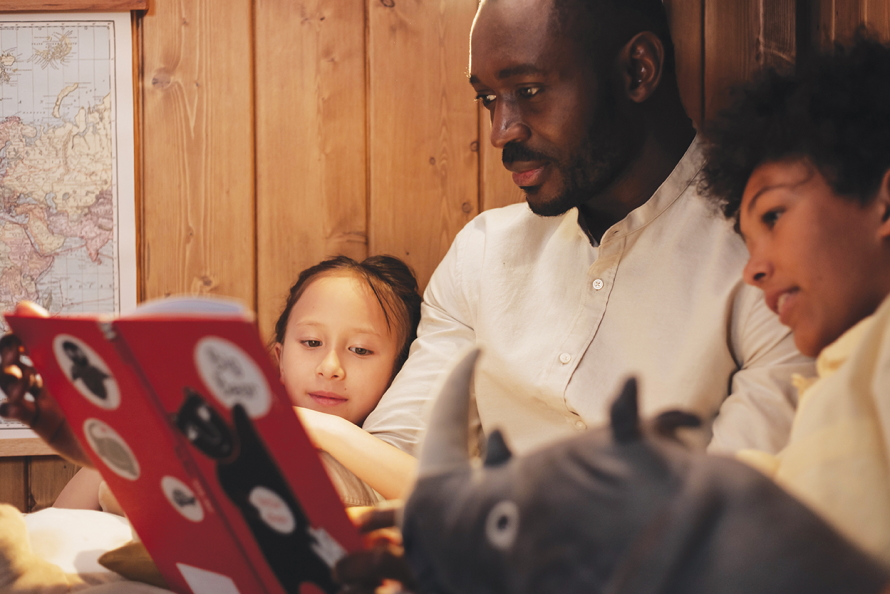
Walking around most major cities in the United States today, Seattle included, it is not hard to notice that our modern families are becoming increasingly multiracial and multilingual. There are many different types of multilingual families, depending on the language resources parents bring into the family.
One of the common aspirations these families may hold is for their children to also become multilingual. However, strategies for one multilingual family may not necessarily work for another family; there is definitely no one-size-fits-all solution. It is my hope that parents will be able to get what they need from this article, and through a process of trial and error, identify a path that would work best for their family.
Is it advisable to raise bilingual children?
Yes, of course! Raising children in a household and community where multiple languages are spoken is not only advisable but actually the norm in many parts of the world. Unfortunately, though more than 150 languages are spoken in the United States, our nation is not known as a multilingual country.
We probably all know someone who grew up with grandparents or parents who speak a language other than English, but somehow that language did not get passed down. English became the only language of the house. This is known as language loss or language shift, which typically happens within one or two generations. While our parents’ or grandparents’ generations may have faced greater pressure to assimilate at the cost of their home languages, society’s attitudes and knowledge about childhood bilingualism have greatly shifted. Research in recent decades has confirmed that raising children who are able to function in two languages reaps multiple benefits.
Within individual families, the benefits include being able to communicate with grandparents and other relatives who may not speak English well or at all. This intergenerational connection is important, not only for developing children’s language skills, but also for promoting family cohesion and supporting the emotional and physical well-being of grandparents. This is probably one of the most important benefits for my own family. My parents do not speak English, and it is naturally easier for my children to learn their language than the other way around. It is a huge relief to me to see my children interact with them readily, especially when they visit Seattle — my children are my parents’ designated translators and they fulfill this role happily!
More importantly, language proficiency is also related to one’s cultural identity. Studies have found that children who have stronger proficiency in a language tend to identify more strongly with the culture of the language. And being able to use more than one language gives our children the opportunity to develop multiple cultural identities.
When they were younger (and obviously hadn’t studied much math yet), my own children believed they were half-Chinese, half-Canadian and half-American!

Another important factor to think about is parents’ own identity in relation to their children. Research on migrant mothers has shown that for mothers who are not native English speakers but are raising children in an English-speaking society, transferring their own language to their children is a pivotal way of maintaining their own cultural identities. In my own case, speaking Chinese to my children definitely makes me feel I am “in my own skin.” My Belgian-born, French-speaking neighbor told me she has the same reaction; it feels strange for her to speak English to her daughters.
Many parents may also have heard about “bilingual advantages,” among them the assertion that bilingual children may be smarter and exhibit better executive function skills. While there have been a large number of studies showing that bilingual children outperform their monolingual counterparts on experimental tasks involving inhibitory control, working memory and other traits, it is also important to note that such effects are not universally found across all studies and that there is also likely a publication bias (meaning those studies that found a significant difference between bilingual and monolingual children are more likely to be published).
For now, I encourage parents to think more about the benefits for the social-emotional well-being of family members, family cohesion and cultural identity development, because positive impacts in these areas stemming from children’s bilingual skills can be more readily observed and registered. The cognitive benefits can be considered the by-products, rather than the goals, of attaining bilingual proficiency.
What are some of the challenges parents may encounter as they attempt to cultivate bilingualism in their children?
Parenting itself is challenging enough, to say nothing of parenting bilingual children! Based on my own experiences of being a parent for 10 years so far, I believe the real challenge began when my children started to attend English-medium schools. Don’t get me wrong: The schools my children attended were all great, but schooling in English and developing relationships with their friends in that language really pulled my children away from the bilingual bubble we were able to create at home up until that point in time.
I distinctly remember one night when my then 5-year-old son was taking a bath and he asked us a serious question: “Why do I need to learn two languages, when all of my friends just need to learn one?” Alerted to, yet gratified by, his level of awareness, my husband and I seized this teachable moment and talked to him about the necessity and benefits of being bilingual, and about our plans and aspirations for him and for our family. I don’t think he questioned us ever again about this!
However, we also have had our share of parenting struggles. Like many parents, we know so little about our children’s experiences inside their classroom at school. I’m sure that many parents, like me, typically get a nonchalant “Good” as the only response to our mundane question “How was your day at school?” It seems that during the elementary school years, it becomes difficult to establish a real relationship with our children in the non-English language. We settle for conversing with our kids in English because of that universal need to relate to them and share with them. On top of this, as children hear and speak English all day long, they may start to think English is the language of authority (since it is the common language of schooling). More importantly, they may not be equipped with the vocabulary and storytelling skills to tell you about their day in the non-English language.
This, of course, is not a good reason for parents to just give up. Parents are advised to help expand their children’s vocabulary from focusing on the home to on school and other leisure activities. Acts of linguistic scaffolding, such as helping them with narrating in different time frames (past, present, future); showing them how to provide details, opinions and talk about emotions; and making or declining a request appropriately, are all critical in strengthening the bond with your child in your language while enhancing their language skills.
Moving on to late elementary school years and middle school, as children develop more personal interests and friendships, their schedules on weekends become busier and busier. They may start to resist their parents’ decision to send them to language schools on Saturdays (many ethnic communities follow this practice).
Academically, parents may also start to prioritize school subjects over languages. It seems that as children grow, their opportunities to use (and actually study) the language become scarcer. This means that from birth to 5 years of age is the golden period for parents to ensure that their children form a strong linguistic foundation in the non-English language that can be built upon later. For parents who speak a non-English language, it is also important to create a strong bond with your children in your language from early on.
As our children begin to socialize outside of the home, it is important for parents to identify and generate activities for children (especially older children) to use, maintain and develop their language skills. Don’t despair! Most middle and high schools in our area do offer foreign language courses, though, in my opinion, at this point in a child’s life, it is way too late, and the school offerings may not coincide with your language of choice — but hey, it’s better than nothing!
My partner and I speak two different languages. What are some of the best practices to employ at home to support children to become bilingual in both languages from birth to preschool?
In my opinion, the first thing to keep in mind is that couples should discuss their “family language policy” as they start thinking about having a child. Trust me, it can get contentious if such issues are not sorted out in advance! A family language policy can be understood as the decision within the home regarding which language(s) to use and by which family member(s). More importantly, the policy should specify the actual actions and how much of an investment a family should make in accomplishing their goals. In making such a decision, couples should think about the following important questions:
- Which languages should be spoken?
- What are your goals for your children for each of the languages involved?
- Do you hope that your children will also acquire literacy skills in the language(s)?
- Do you want your children to be able to actively use the languages or is it sufficient for them just to understand the languages?
- In order to support your goals, what are your options for in-home care, day care, schools and so on?
- Which family member will be primarily using which language with the children?
- Would the family member, especially the one in charge of the non-English language, be able to provide sustained, high-quality language input to the children?
- Would the English-speaking family member be able to support the bilingual practice at home, knowing that sometimes he or she may not be able to understand some of the family interactions?
- What would be the language for conflict resolution?
- What language(s) would the family use when English-only guests visit the home?
One of the most popular family language policies among bilingual families is the “one person, one language” (OPOL) policy. This is the one we have adopted at our home. However, since a child’s exposure to the two languages is rarely equal, especially when they attend an English-only school, the non-English language often suffers. At this point, if the parent who speaks the other language is also bilingual, then the child may start to respond in their stronger language, typically English.
Gradually, the child may start to lose productive skills (such as speaking) in the non-English language. In fact, researchers have found that across a sample of 2,000 families, one-quarter of the children brought up with the OPOL approach did not end up bilingual. Why? Research findings regarding bilingual families can be summarized succinctly: Successful bilingual learning is dependent on the amount of exposure children receive and the opportunities they have to use the language. So, it is important for parents to keep in mind that the more your children hear the language, the more your children use the language, and the more likely they will be able to acquire it. It isn’t rocket science.
That said, be flexible, and regularly revisit, review and revise your family language policy with your partner, since your family’s situation may change. The ultimate goal for every family, I believe, is the well-being of all family members.
Let’s say my partner and I speak two different languages, neither of which is English. What should we do in this situation?
I would highly recommend the parents discuss the list of questions presented above regarding family language policy (e.g., which languages, by whom, how and how much, etc.). This is especially true for languages that are hard to learn and maintain because of a lack of resources and support. In such cases, parents should consider the feasibility of teaching their child this language at home.
I have interacted with some multilingual families that have decided to let their children learn a language that is different than those of both parents because a dual-language immersion program is accessible to them. Although the family language policy you make is ultimately dependent on your family, your location and available resources, among other external factors, do limit the choices you have.
If a multilingual family does wish to consider introducing multiple languages, many of the family language strategies that apply to bilingual families can be adapted. In addition to the OPOL family language strategies mentioned above, there are other possibilities that multilingual families use.
The first alternative is “one language first.” As the term suggests, families can ensure that the child becomes established in learning the first non-English language, usually around age 4 or 5, and then can introduce the second non-English language at home.
The second alternative is the “language time” strategy. For instance, families can decide that mornings are dedicated to using language A and afternoons for language B. Such a strategy is also adopted by many dual-language immersion programs that offer instruction in two languages.
Another possibility, which might be the most natural one for multilingual families to employ, especially when parents are proficient in all of the languages involved, is to use the languages interchangeably, letting the topic, speaker, situation and mood determine the language to be used in context. This is actually how a multilingual person naturally functions in a multilingual environment.
Unfortunately, it is not possible to offer a straight-up success rate for each of the strategies explained above. How well children learn is ultimately dependent on a multitude of factors. Regardless of the composition of the languages of your family, I cannot overemphasize two critical factors: exposure and need.
Exposure should be abundant, consistent and come from authentic interaction with human beings, rather than from a tablet, as a University of Washington I-LABS study shows, or from passively watching TV in the language.
The second critical factor is need. Do your children have a genuine need to use the language in order to communicate with a parent or other family member? If the parent readily switches to the children’s favored (i.e., “stronger”) language, then there isn’t a need. Do the children need to watch a cartoon in the non-English language? If they are allowed to freely watch the cartoon in English, then there is not a need.
These two factors are closely related. If the non-English parent is able to provide a consistent amount of language exposure to the children early on, then the bond is established in that language. As the children grow, they also develop a perceived, if not an organic, natural need to continue using that language with that parent.
Some parents report that their children can understand everything that is spoken to them [in the non-English language], but reply in English. What are some things parents can do to encourage their children to respond in the non-English language?
Again, this goes back to the family language policy. What is the goal of your bilingual parenting? Is it just to help your children develop receptive aural understanding, or it is to help them foster productive skills, such as speaking? If it is the latter, then parents should come up with ways to encourage the child to use the language and catch them when they slide. Also, it helps to openly discuss your plans and aspirations with your child, such as the bathtub conversation we had with our 5-year-old.
In our household, we implemented the OPOL policy from day one and have remained quite consistent. I speak to my children in Chinese and expect them to respond in Chinese. While my children have been doing well in this regard, every now and then they will make a request or ask me a question in English. My first instinct is to pause and simply ask them to repeat the request again, this time in Chinese. Yes, there are words they might not know and they will mix some English words into their Chinese sentences.
Parents can compensate for the lack of vocabulary with a strategy that teachers use frequently: recasting. Simply put, parents can recast a “problematic” sentence by repeating the sentence back to the child in a “corrected” way, instead of pointing out any “errors” directly. This approach avoids obstructing the original communication. (Quotation marks are used here because I do not consider children’s language as mistakes. They’re just developing their language skills.)
No one likes the feeling of being corrected all of the time. It is advisable to think about whether the goal is to encourage more self-initiated language use or reluctant use in correct forms only. I also strive to create authentic tasks that would require my children to speak in Chinese, and upon completion, they’d feel intrinsically rewarded. It can be as simple as asking for a fork from a waiter in a Chinese restaurant, or discussing with their grandparents what gifts they would like to receive for their birthdays.
If feasible, it would be ideal to travel with your children to the country or region where the non-English language is predominantly spoken. You may even consider registering them for a summer camp during your travels. Children will not only soak up the language while being immersed in it, but also develop fond memories associated with that destination, the people, the food and, of course, the language.
What are some ways for parents to help their children maintain their language proficiency while not having to continuously fight with them about language choice?
I think it is useful to talk with your children about why they are unwilling to use the non-English language. Is it because they think it’s not good enough or because they were mocked at school for speaking the language (a situation that should be discussed more seriously with school administration), or because they simply do not have adequate language skills to perform the more demanding communicative tasks?
If the latter is the reason, parents should consider providing more modeling and scaffolding. If it isn’t for any of these reasons, then parents should consider the two critical factors I mentioned above: Exposure — does the child have enough exposure to the language so they feel comfortable and confident to use it; and need — does the child have a need to use the language? If not in either case, then parents should strive to identify ways to fortify their relationship with their children in the non-English language by “creating” some of the needs.
In this regard, one of the suggestions I learned from a parenting podcast is quite useful for me: Learn something new with your child. Develop a common interest with them so that you can continue to enjoy each other’s company in a context in which you will use that language organically.
For instance, a Spanish-speaking parent friend of mine started playing “Breath of the Wild,” an Xbox game, with her fourth-grader, and they would discuss the roles and plots in Spanish. The child would readily follow because he is interested in the game. The mother revealed that she actually didn’t know how to say some of the game-related terms in Spanish and had to look them up. To me, that is a great instance of being a role model for the child — there is always something new we can learn, and it is fun and rewarding to learn together. On this journey, the mother became a partner, a playmate and a friend to her son.

In our house, we read a lot with the children. My husband and I take turns reading to them at bedtime, in English and in Chinese on alternating days. Decades of research have shown that reading with your children has numerous benefits, one of which is that it contributes to their language development and expansion of knowledge. This, in turn, leads to better literacy skills later.
For us, reading Chinese books together allows my children to access the rich tales, fables, fantasies and history that they wouldn’t otherwise be able to do independently. It also allows me opportunities to read books (such as martial art novels) that I didn’t have the chance to read when I was younger. I’m not too stressed out about having them recognize and memorize Chinese characters yet, because a strong language foundation is the basis for learning to read. And rote memorization can easily take the fun out of learning. With a strong language foundation, they can pick up learning character rather quickly later on, given ample exposure and an authentic need.
What about when they enter elementary school, where English is the only language of instruction?
While pre-K–12 dual-language immersion programs are becoming increasingly more available across the country, they may not be accessible to all. If bilingualism or multilingualism is your goal but you only have the option of sending your child to an English-speaking day care or school, what can you do to make sure schooling does not derail your family’s plan? From my personal experience and based on the wealth of research available on this topic, some of the basic questions parents can ask their child’s educators include:
- Are there teachers who speak the language your child is learning?
- If so, is it possible for them to teach some nursery rhymes or to read some children’s books in that language?
- Are there other families in the same school who also speak the language?
- Is it possible for the parent or a group of parents to organize linguistic and cultural events at the school that educate others about the language, culture and traditions?
It is powerful for a young child to learn that the language mom or dad speaks is also shared and appreciated by others outside of their home, and that the child’s effort to learn the language is appreciated. It is also important for educators and organizations to recognize and value the linguistic resources that each child possesses through its daily teaching strategies and intentional school programs.
As a mother of two bilingual children, what are some of your successes and challenges in your journey so far?
For me, the worst moments came during the COVID-19 pandemic when we could not visit our respective parents (in China and in Canada) and could only communicate with them via Zoom. However, it was heartwarming to see my kids be so absorbed by the stories my parents read to them over Zoom; for a moment, the distance across the Pacific was erased by technology.
The best moments happen every day as I watch them grow and thrive in the bilingual environment we strive to create for them. Our ultimate reward would be when they spontaneously use the two languages creatively or create a pun that only bilingual speakers can understand.
Fostering the positive relationship your children have with you, your language and your culture is a small seed that can grow into a giant tree. Even if you are not able to help your child become as bilingual as you had hoped, as long as they feel confident about the language and the culture, they can always continue to learn in college and beyond.
Resources to support bilingual learning at homeThere are many ways you can support your child’s bilingual/multilingual development through play, community engagement and fun everyday activities. Play is always the way
Community engagement
Everyday language-learning activities at homeThe Australian parenting website has scads of great ideas for exploring bilingualism at home. Here are just a few suggestions:
— Kari Hanson |











